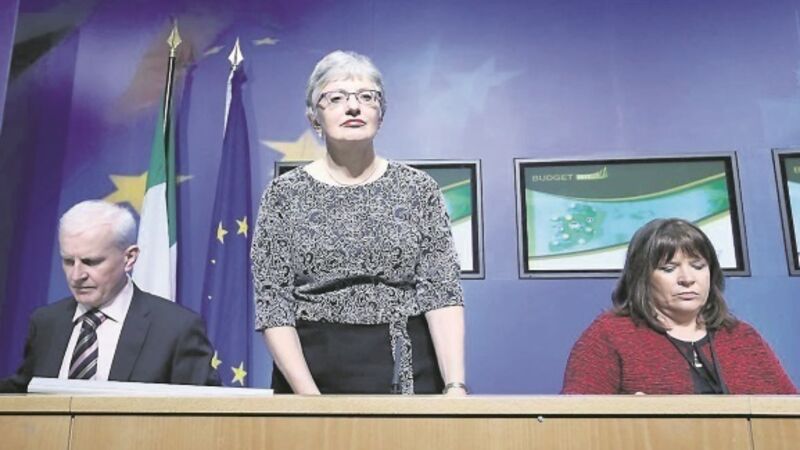Hollowing of tax base will lead to bitter recriminations (again)

YESTERDAY’S budget was a continuation of an embedded trend of having ever more public expenditure, depend on an ever-reducing tax base. Individual measures were modest. Many were simply inconsequential. That reflected the necessity of accommodating unprecedented political diversity. Some will quibble at the bittiness of initiatives that could have been targeted at fewer, more concerted measures. But that is what we, the people, voted for, and in that respect, we have exactly what we deserve.
It is the cumulative trend of policy that matters, however.
Unquestionably that policy direction is back to the future. In particular it repeats one of the most destructive elements of the boom and bust of the Celtic Tiger, namely a continuous and pernicious narrowing of the tax base. The irony is that with limited room for manoeuvre, the further, albeit slight, reduction of the tax base, cuts capacity to cut tax rates and assist competitiveness at the critical pinch point where workers enter the higher rate, on astonishingly modest earnings.
Our recent catastrophic collapse was based on far too steep a rise in public expenditure — mainly public service pay — funded by unsustainable taxes, too reliant on jobs and transactions in property. The cocktail became poteen, because simultaneously that unsustainable spiral of tax cuts and pay increases, was funded from an ever narrower tax base, as more and more were excused entirely from paying any direct taxes.
The knockout blow was the banking crisis and its consequently enormous, but one-off bill. Current spending is recurring. A reduced tax base leaves permanently reduced capacity to meet current obligations. That is why we were economically asphyxiated in the downturn. But that was then, and this is now. So, no matter.
Now, we begin again, where we left off and the smallest of details, sums up the story. The 1% rate of USC was reduced yesterday to 0.5%; and the 3% rate reduced to 2.5% and here’s the nub. The minister increased the ceiling of the band on which the reduced 2.5% rate of USC will be payable from €18,668 to €18,772. This increase ensures that the salary of a full-time worker on the minimum wage will remain outside the top rates of USC.
We have re-arrived with gusto at recently discarded policies where swathes of the workforce were excluded from paying little or anything by way of direct taxation. This policy choice not only neuters a possible tax cut for those also modestly paid, who because they earn only a little more, unfairly pay multiples in taxation. Worse, is that investment in services proportionately needed most by the lowest paid, is correspondingly reduced. Come a downturn — and downturns always arrive — it is people most dependent on public services who suffer most and suffer first, as the necessary fiscal correction is made. But that was then, and this is now.
Back then, in 2008, 42% of people were out of the tax base entirely. It was a Ponzi scheme. The revenge of events meant that in 2011, only 12% were afforded a pass from contributing directly to the upkeep of the country they live in. Regrettably, this year amidst more people at work earning more income, 29% paid no direct taxes. That is amnesia on an industrial scale. On the basis of current policy, more accurately engrained political attitudes, that figure is set to grow. What stood out for me yesterday was the cultural legacy of the policy conversation which is the new normal. The specific measures were piecemeal but the overall direction is wrong. The mésalliance of “pay restoration”’ with pay levels which were originally unaffordable and a tax base, incapable of paying for it, will eventually end in bitter recrimination again.
One right-thinking policy, focused on families who need it most is Katherine Zappone’s new single affordable childcare scheme to be introduced from September 2017. There will be means-tested subsidies, based on parental income, for children between six months and 15 years and universal subsidies for all children aged six months to three years. Importantly, subsidies will be paid for “children and young people attending a Tusla-registered childcare provider, including centre-based providers and child minders”. The contrast is with the largesse of pension payments across the board, regardless of income, in what was clearly a game of political leapfrogging for the grey vote. But every choice comes at a cost, and that choice came at an enormous cost. The political choice of course, was to make no choice and instead profligately give one to everyone in the audience — from scarce means.
The problems with budgets rarely arrive on the day they are announced. It is only after reflection that a backlash begins. Perhaps, whatever the underlying policy trend, just enough has been spread widely enough to avert that. But on childcare the ghost of individualisation hovers. Then, the stay-at-home spouse, overwhelmingly female, rebelled though they had lost nothing. The spectre of the single, the flighty and the working, receiving equal tax treatment sparked outrage. It was a political crisis of the first order for Charlie McCreevy.
The amour propre of Mother Ireland was mortified and amends had to be made. It will be interesting to see if similar offence is taken by the stay-at-home now. Looking at other women, careering to work, availing of additional subsidies not available to those who choose to keep their children at home, will be a test of the Irish character. Let’s see.
In the fulcrum of budget-making, long-term policy trends habitually receive too little attention. It is truly a case of “one day at a time sweet Jesus”. The political pressures are acute. This time, they were also astonishingly complex. And this budget is based on a bet.
Yesterday the minister for finance forecasted a deficit of just 0.4% of GDP in 2017. The ceiling allowed under the EU rules we signed up for is 0.6%. That is a sliver. All the fundamentals, except the currency exchange rate, are going the right way for now. Still growth next year is forecast at 3.5%, down from 4.2% this year.
Growth forecasts are always an informed guess at best. In the circumstances of Brexit the number of variables are increased. While a lot of public spending is reducible in a crisis, politically some has proven impervious.
Entitlements, especially universal entitlements given regardless of income to pensioners, are apparently in that category. And the conversation unbelievably is all about “restoration”.
It is again about hollowing out a tax base, to pay too much to public servants, and spend dissolutely on universal entitlements, while the greatest needs go unmet. The incrementalism of the conversation and insidiousness of the steps by which it is fulfilled, leaves us lax.
The critical issue is seldom any specific measure in one budget. It is the broader trend over a number. The blandness of most of what passed yesterday should not distract from the cumulative outcome.
We have re-arrived at recently discarded policies where swathes of the workforce were excluded from paying little or anything by way of direct taxation












